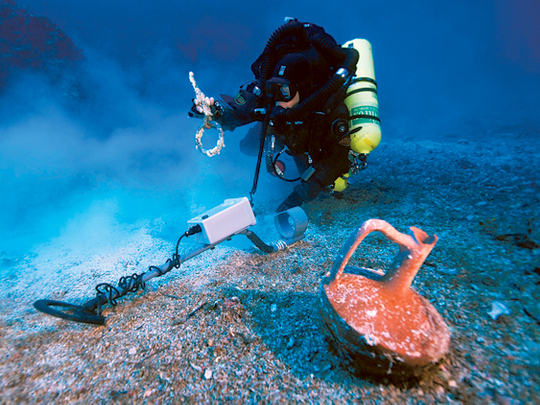
Athens: Archaeologists armed with top-notch technology have scoured one of the richest shipwrecks of antiquity for overlooked treasures, recovering a scattering of artefacts amid indications that significant artworks may await discovery under the seabed.
Lying metres down a steep underwater slope off Antikythera Island, in southern Greece, the Roman commercial vessel’s wreck was accidentally located by sponge divers more than a century ago.
Using primitive suits and assisted by the Greek navy, they raised marble and bronze statues, luxury tableware and the so-called Antikythera Mechanism, an entrancingly complex clockwork computer that tracked the cycles of the Solar system and could predict eclipses to a precise hour on a specific day.
For years too deep for proper investigation, the wreck is now accessible through modern applied science.
Over the past three weeks, a US and Greek-led team comprehensively mapped the seabed, despite being hampered by strong winds that only allowed archaeologists a single day’s use of their star gadget — an Iron Man-like diving suit, likened to a wearable submarine, that can take its wearer more than 300 metres (985 feet) deep without the dangerous and time-consuming process of decompression.
A Greek Culture Ministry statement on Thursday said divers raised sample artefacts — a bronze spear probably belonged to a larger than life-sized statue, metal fittings from the 1st century BC wooden ship, a pottery flask that may have contained wine or oil and a metal leg from a bed.
But excavators hope much more may lie beneath the sand.
“I don’t know what there is there — perhaps more works of art or parts of the ship’s equipment, but we really have to dig,” said Angeliki Simossi, head of Greece’s underwater antiquities department who coordinated the large team that included Greek navy Seals.
Floating museum
“[The spear] is not connected to any of the known sculptures from the wreck.”
Simossi said the freighter, believed to have been sailing from a Greek island to Italy, was carrying works of art from Roman-conquered Greece that had been specifically requested by rich or cosmopolitan Romans to decorate their villas.
“It was a floating museum, carrying works from various periods” one bronze statue dates from 340 BC, another from 240 BC, while the Antikythera Mechanism was made later,” she said. “This was when the trade in works of art started.”
The ship was at least 40 metres long, and sunk some time in the 1st century BC on what is still a busy trade route between mainland Greece and the southern island of Crete.
Senior team archaeologist Brendan Foley, of the Woods Hole Oceanographic Institution in Massachusetts, said evidence from the site shows it to be “the largest ancient shipwreck ever discovered.”
“It’s the Titanic of the ancient world,” he said.
A survey of the seabed with metal detectors located strong signals which could point to ancient artefacts that eluded the first divers in 1901 — or to more mundane finds like the lead sheathing of the hull. Excavators hope to resume the survey next spring, a time of year when the weather should be better.
“We have to continue, it can’t stay at this. But it’s very difficult, the sea is open,” Simossi said.
“There’s an element of bad luck. Past investigations were also plagued by bad weather. It’s as if the wreck doesn’t want to be uncovered,” she added.












